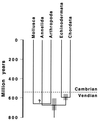Origin of the metazoan phyla: molecular clocks confirm paleontological estimates
- PMID: 9435239
- PMCID: PMC18467
- DOI: 10.1073/pnas.95.2.606
Origin of the metazoan phyla: molecular clocks confirm paleontological estimates
Abstract
The time of origin of the animal phyla is controversial. Abundant fossils from the major animal phyla are found in the Cambrian, starting 544 million years ago. Many paleontologists hold that these phyla originated in the late Neoproterozoic, during the 160 million years preceding the Cambrian fossil explosion. We have analyzed 18 protein-coding gene loci and estimated that protostomes (arthropods, annelids, and mollusks) diverged from deuterostomes (echinoderms and chordates) about 670 million years ago, and chordates from echinoderms about 600 million years ago. Both estimates are consistent with paleontological estimates. A published analysis of seven gene loci that concludes that the corresponding divergence times are 1,200 and 1,000 million years ago is shown to be flawed because it extrapolates from slow-evolving vertebrate rates to faster-evolving invertebrate rates, as well as in other ways.
Figures



References
-
- Dobzhansky T, Ayala F J, Stebbins G L, Valentine J W. Evolution. San Francisco: Freeman; 1977.
-
- Valentine J W. Syst Zool. 1973;22:97–102.
-
- Valentine J W, Awramik S M, Signor P W, Sadler P M. Evol Biol. 1991;25:279–356.
-
- Lipps J H, Signor P W, editors. Origin and Early Evolution of Metazoa. New York: Plenum; 1992.

